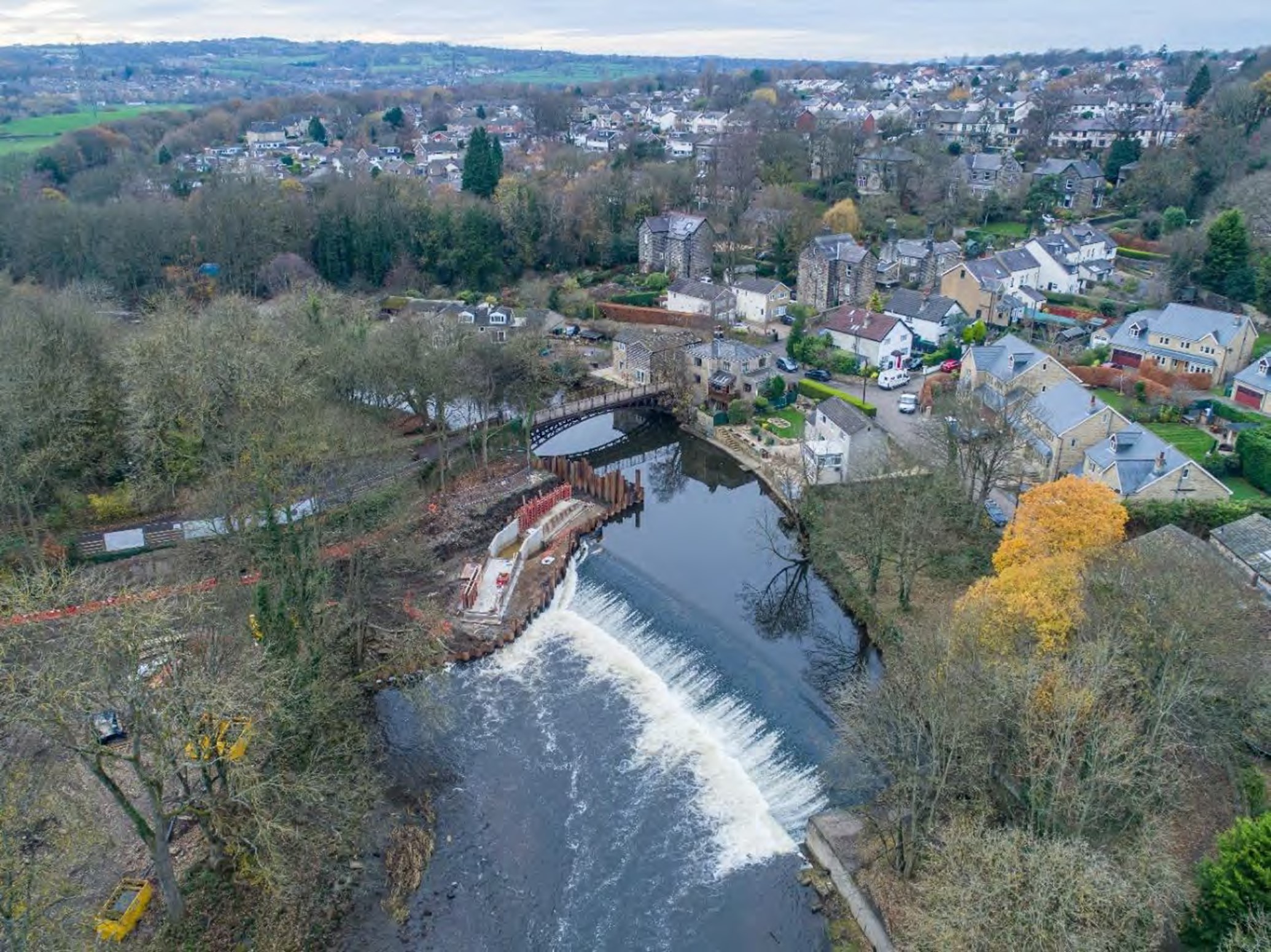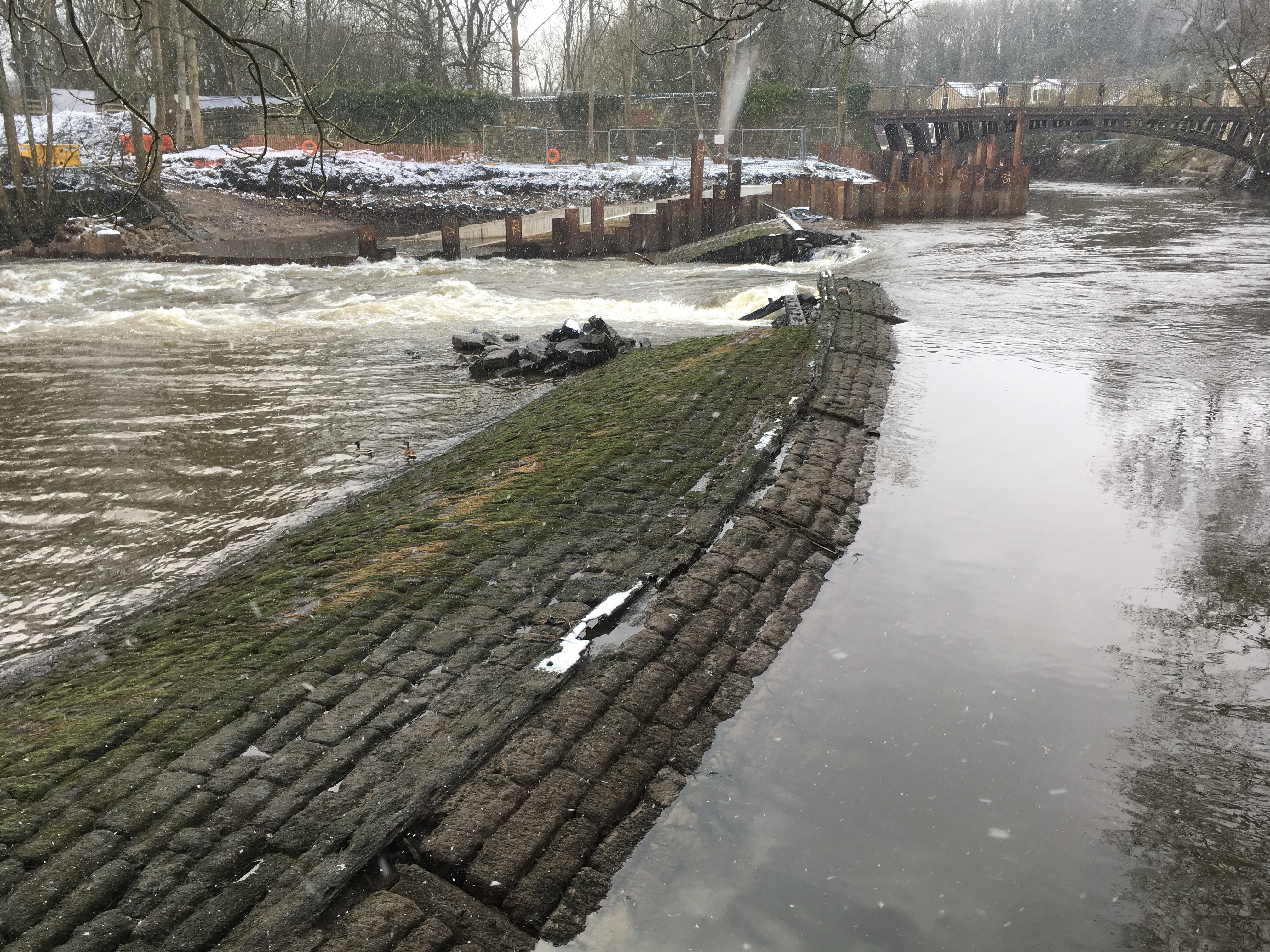Newlay Weir and Fish Pass
Results updated 27 Jan 2023
We have issued an update regarding Newlay Weir and Fish Pass. You can view it here or by using the link at the bottom of the page.
We have now published the results of the survey. You can view it here or download using the link below.
Files:
- Survey Summary, 716.8 KB (PDF document)
- Update January 2023, 122.7 KB (Office Word 2007 XML document)
Overview
Background
Newlay Weir is situated on the River Aire, in the lower River Aire valley, upstream of Leeds. Initial development in the Newlay area began with the construction of a weir and goit in the 12th century to power the corn mill at Kirkstall Abbey. The current Newlay Weir was constructed in 1690 to provide water to Kirkstall Forge Mill. The weir was listed (Grade II) in 1996 under the Planning (Listed Buildings and Conservation Areas) Act 1990 for its special architectural/historic interest, and contributes to the setting of the grade II Newlay Bridge.
As part of a strategy for ecological improvements on the River Aire, the Developing the Natural Aire (DNAire) project began construction of a Larinier fish pass along the right bank of Newlay Weir, designed to allow passage over the weir for salmon and sea trout which migrate from the Humber Estuary to the headwaters of the River Aire.

Drone view of Newlay Weir (30-11-2020) - Arup Report
In June 2020, work started to construct the fish pass adjacent to the weir. During construction, in late January 2021 the region was hit by Storm Christophe. Following the storm and subsequent flooding, the weir failed and a large portion of it was washed downstream.
Following an independent report into the causes of the collapse, the Environment Agency is now gathering information on options to inform its decision on what actions to take at Newlay weir and the fish pass.

Image showing collapsed section of weir.
Independent Report into the Collapse
The Environment Agency commissioned Arup to independently investigate the factors that could have contributed to the collapse. You can read the full report here and there is also a download link at the bottom of this page. Table 5 on pages 61-62 details the relative significance of a number of combined factors likely to have contributed to collapse.
Your Views
Since receiving this report, the Environment Agency would like to ask the local community and river users their views on the future of the weir, and the fish pass. This survey asks for your opinions on what matters most to you. You can submit your views on the following pages, and we have included free text boxes so you can expand on these if you wish.
You can submit your views by clicking in the box below. If you prefer you can request a hard copy from the email above, or download a Word version from the bottom of the page.
For those unable to comment on-line, there will also be a paper copy of the survey available to view at Horsforth Library and at Bramley Library along with paper response forms from the afternoon of Monday 4th July.
You can post your comments back to us at
Newlay Project Team (C&E), Environment Agency, Lateral, City Walk, Leeds, LS11 9AT.
What happens next?
As we work towards solutions for the future of the weir and fish pass, we will look at your views alongside other considerations which are shown below. We would like to emphasise that this is a complex situation; we are presently at the stage of gathering information on options to inform us what may be possible.
Considerations
With this survey we aim to gain an understanding of your views. Your input will allow us to take account of what’s important to you alongside the other factors we need to consider. These are listed below:
- We are committed to the Water Framework Directive (WFD). This seeks to actively remove barriers from rivers to improve biodiversity and natural flow regimes.
- We have organisational priorities that we must take into account. The two main ones in this situation are;
- Increase the resilience of people, property, and businesses to the risks of flooding and coastal erosion
- Protect and improve water, land, and biodiversity
- We seek value for money wherever possible in the use of public funds
- Newlay weir is a grade (II) listed structure and the heritage of this structure is significant to the area
- Fish and eels are an important element of the biodiversity of rivers, and migration is a part of their natural lifecycle, so we must carefully consider their requirements whilst considering the future of any weir
- A Flood Risk Activity (FRA) permit would be required for any works which alter the state of the river in the area to something other than its pre-construction state or the targeted state of the DNAire programme for which a permit was acquired
- We have to take account of any legal factors which may influence decisions
- There are numerous stakeholders with a vested interest in the future of Newlay Weir and the associated fish pass
- Important to note - Some of the potential options for the weir and fish pass are connected. For example, if the weir was to be rebuilt the fish pass would need to remain in place because we would need to ensure fish can pass the reconstructed weir.
Why your views matter
With this survey we want to hear your views. Your input will allow us to take account of what’s important to you alongside the other factors listed above, which we need to consider as we work towards any decisions.
Audiences
- Members of the public with an interest in the river, the species and conservation
Interests
- Habitats and wildlife

Share
Share on Twitter Share on Facebook